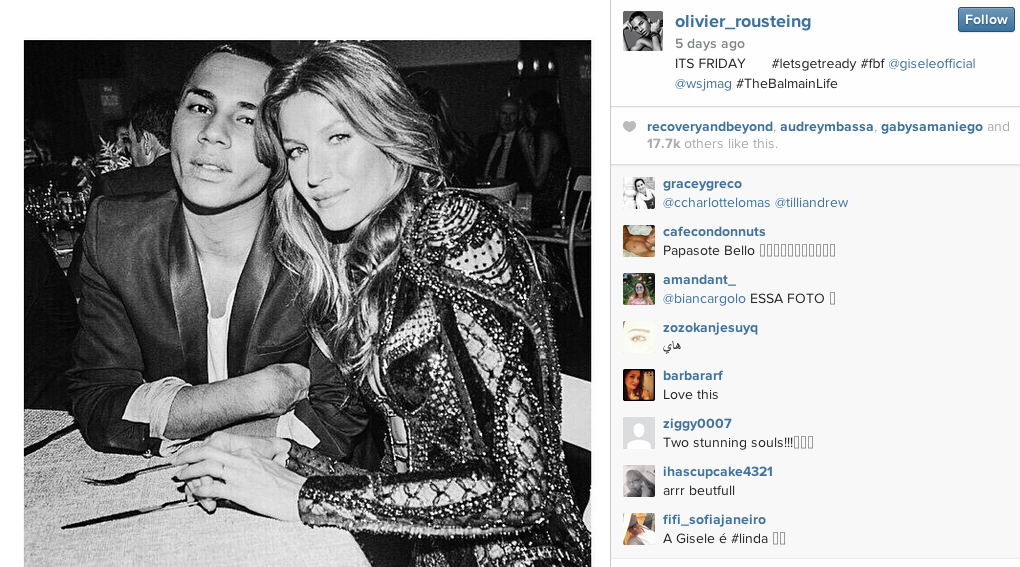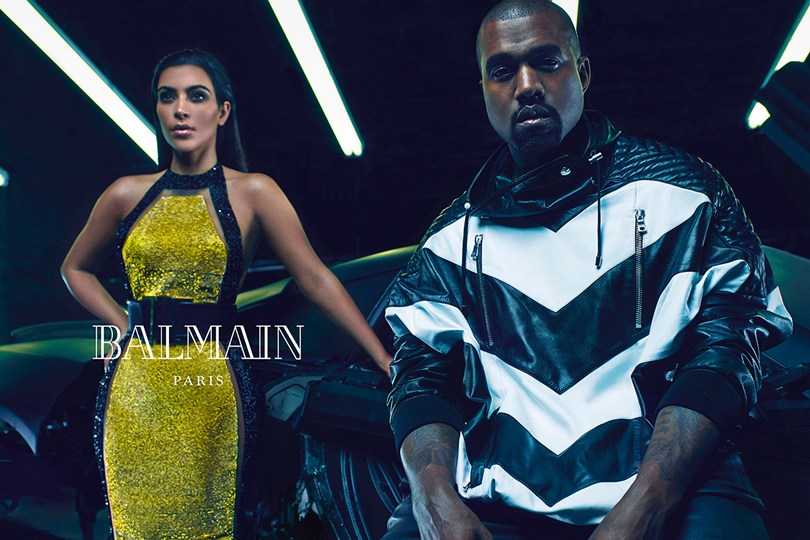Kim Kardashian and Kanye West at the Balmain show during Paris Fashion Week Womenswear Spring/Summer 2015.
The fashion industry has never been short of rock-star designers: Yves Saint Laurent setting flashbulbs popping in Studio 54; John Galliano swaggering down the catwalk for post-show bows at Dior. But what does the designer as rock star look like in the Instagram age?
One possibility is presented by Olivier Rousteing, 28-year-old creative director of Balmain. Rousteing certainly has a face for social media – the sort of features the rest of us fail to achieve even when we suck our cheeks in and apply filters. He puts them to good use on his Instagram feed, where almost a million followers get a daily glimpse of the Balmain lifestyle: glitzy shots backstage at catwalk shows; pictures of parties on Dubai beaches with impossibly beautiful, sometimes famous, friends.
Rousteing’s catwalk shows have become frenzied fashion “moments”. At the unveiling of his spring/summer collection in September, men in suits jostled for seats while Kim Kardashian and Kanye West were blinded by the lights of a scrum of paparazzi from the front row.
In person, Rousteing is every bit as chiselled as his Instagram persona (is there such a thing as selfie resting face?), although more softly spoken, sincere and thoughtful than that image might suggest. Dressed from head to toe in black (Cheap Monday jeans, a Ralph Lauren cashmere sweater, fashion’s regulation-issue beanie), he speaks in elegant, French-accented English peppered with the occasional Valley girl phrase (his parents are “like, literally” so proud of him) and conversation veers from a detailed analysis of Cristóbal Balenciaga’s technical skills to the restorative post-party properties of McDonald’s food.

As well as his youth and beauty, Rousteing stands out for being a black designer in the top creative role at a storied design house. This puts him in a category of one in fashion, an industry that, “for the most part”, he says, “is playing the same game with the same people”. While many designers are criticised for casting mainly white models in their shows, the “Balmain army”, as Rousteing calls them, are always ethnically diverse. He believes the rest of the industry is missing out if it fails to follow suit. “I think it’s because the same people from the 1980s are still on top,” he says. “If they started to go out on the street more, and see how the business really is and who is actually spending money, they would realise that diversity is what helps fashion to still exist.”
Rousteing’s backstory has a fairytale quality: he was born in France and lived in an orphanage until he was one and a half, when he was adopted by a white couple from Bordeaux. His mother was an optician, his father a port manager, and he says his childhood was “perfect, amazing”, very French, very traditional and conflict-free until his late teens, when he realised he didn’t want to become an international lawyer, as his parents had hoped, and moved to Milan to break into fashion. He apprenticed with Roberto Cavalli from the age of 18, stayed for five years (“Italian brands show you – with the money and the power that they have – that they can get everything really quick and really fast. I loved what I learned from them but I think I left because there was a side of their glam that I was no longer into,” he says), then worked under Christophe Decarnin at Balmain.
Decarnin famously dragged Balmain kicking and screaming into the noughties, working with the super-stylist Emmanuelle Alt to transform the label from an off-radar traditional couture house to the toast of the French Vogue set. Known for extreme, highly expensive pieces – ripped, crystal-embellished jeans; biker jackets with spike-shaped shoulder pads – Decarnin’s designs were copied on high streets throughout the world. At the tail end of the hectic period of “Balmania”, he suddenly left the company, and his replacement was a wild card – his right-hand man, Rousteing, then 25 years old, practically a zygote as French fashion houses go.
Rousteing puts his ascent down to ambition, a competitive streak and a workaholic nature: “I always push myself. I want to be first in everything. I want everything fast and I can’t wait.” His drive, he says, “comes from my birth. I was born in an orphanage, so I feel like anything is possible – there are no limits. When you come from nowhere you feel like the world belongs to you.”
“Obviously it was a bit scary,” he continues, “but until you are on the catwalk saying thank you to 500 people and seeing Anna Wintour in the front row you don’t know what [the pressure] is like. Honestly, I think my first collection was really pure. It wasn’t until the end of the show, when I had to go and thank everyone, that I realised my life was going to change; that it’s me under the spotlight. You realise that being an image of the house, as a creative director, is very different to being a designer.”
Under Rousteing, Balmain is still about high-octane glamour – his most famous creations include form-fitting dresses, embellished with the patterns of a Fabergé egg – and he says his vision for the customer is one of confidence. Even when the skin is covered, he says, “Balmain is not about hiding, it’s about showing.” Though this idea is somewhat at odds with the androgynous, understated silhouette that has captivated much of fashion in recent years, it certainly appeals to the young, international and moneyed. Balmain has its eyes on expansion – key markets include London, the bestseller, Italy, China, South Korea and the Middle East – with a stock market flotation the eventual goal. The opening of Balmain’s first European flagship store, in South Audley Street, Mayfair, at the end of January, is a significant part of this plan.

The ideal customer, says Rousteing, is someone like his friend – now also a Balmain campaign star – Kim Kardashian. “She is insanely beautiful, smart, confident, a business woman. I love also that she is not a typical American. She has Armenian origins, she is with Kanye, who is black, and she has a mixed-race daughter. For me, that is how modern couples are.” Kardashian and West are not universally adored by the fashion-loving public, many of whom flooded social media with complaints when the pair appeared on the cover of Vogue last year. This snobbery exists, he believes, because “they don’t understand that this is the new world. They will understand in three years. But it’s going to take time.”
Rousteing is obsessed with the modern, the fresh, the new. His most recent collection was themed around censorship, and featured transparent dresses with glittering black panels across models’ chests. It was partially inspired by Rihanna, who had been banned from Instagram for six months for posting explicit pictures. Though some fashion journalists criticised this concept – suggesting that Rousteing was reflecting pop culture rather than moving it on – he sees depth in the theme: “I’m not acting like a teenager and saying: ‘Oh my God, social media is really important.’ It is more that, as a business person, I see that Instagram is the new way of selling and of communicating. So, as a business person, I was wondering, what are the limits of social media? What can we communicate? It was important for me to show the limits of what you can show and what you can’t show.” And if you still don’t get it? Fashion’s most powerful millennial is confident that you will do, eventually. © Guardian News & Media 2015